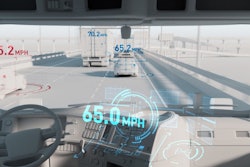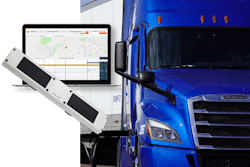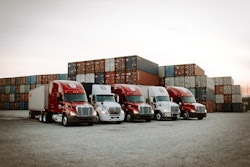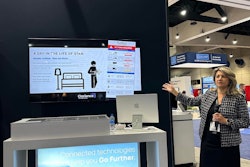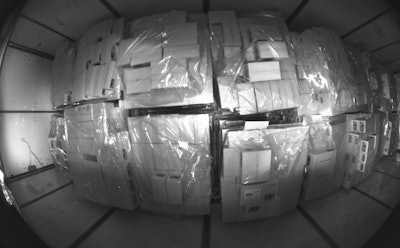
Carriers have experienced a slight softening of the market as of late, but Cargo Transporters Chairman John Pope said capacity has remained tight for the most part post pandemic, resulting in increased dwell times.
Regardless of whether utilization is at its peak or in a dip, fleets are always wanting to improve their trailer utilization to boost their bottom lines, and with a slowdown of new trailer builds over the past year, maximizing use among existing trailers that may currently be in service beyond their typical trade cycle is key to keeping revenues up.
The number one way fleets can do that is to analyze idle times to keep trailers moving, said Debbie Sackman, senior product manager at SkyBitz, which provides cargo sensing and trailer tracking technology.
According to data from supply chain visibility platform FourKites, the monthly average facility dwell time as of October was 2.8 hours for both delivery and pickup stops made across its customer network. The data shows that there has been a slight uptick in dwell time for pickup stops over the past few months as average facility dwell times have increased by 7% since April.
SkyBitz monitored idle times of trailers belonging to six motor carriers of similar size – three using cargo sensors and three not.
“One of the things we've noticed when we help companies benchmark how they're doing in terms of their idle time and utilization time is we look at those idle times from comparable fleets that do have cargo sensors and don't have cargo sensors, and we help them see that there's actually quantitative proof that having cargo sensors and using that cargo sensor data proactively definitely reduces idle times,” Sackman said.
SkyBitz recently released its new Kuantum platform – a trailer tracking device that comes with a built-in cargo sensor to optimize trailer capacity and utilization by reducing unproductive trailer idle time, automating yard checks and other manual tasks, monitoring and verifying detention with arrival, load/unload and departure data, and decreasing reliance on customer notifications to schedule pickups.
“We found a huge value in knowing that data, and it makes a huge difference in our asset utilization, along with helping the driver save time in having to manually go look at a trailer and tell us this trailer is loaded or unloaded,” said Pope, whose company uses the former iteration of the SkyBitz Kuantum.
Prior to using cargo sensors, he said drivers did have to do a physical inspection of the trailer, or the carrier had to call the shipper to determine its status, both of which was “aggravating” and time consuming. Now, his company knows almost instantly when there’s a status change to a trailer.
“We know right away that the trailer is empty so that way, if we have a truck in the area that needs the empty trailer to take to another customer to load for outbound freight, we can immediately go ahead and route that rather than consuming somebody else's time with trying to determine status,” Pope said.
Knowing the load status, idle time and location of a trailer allows carriers to proactive take action to turn trailers, Sackman said, and it provides data they can use over time, like determining which locations have the longest idle times and what’s causing that, for example.
Providing carriers with tools to measure data, from dwell times to usage rates, has helped the fleets using Orbcomm’s trailer products to gain operational insights around key metrics like turn time within the distribution center, load/unload times and detention metrics. While many fleets are primarily interested in the trailer load state, new image technologies, along with AI and machine learning, are rapidly moving cargo data beyond the traditional loaded or empty state to cargo images and volumetric load sensing, helping fleets further maximize trailer space as well as determine load condition, said Orbcomm Senior Director of Product Management Chris Corlee.
He said all of these insights can help fleets recover lost revenue from excessive detention, identifying under-utilized assets to right size trailer pools and providing statistics about the shipper and receiver to support future rate adjustments.
“Orbcomm provides a comprehensive solution, including our telematics hardware, that seamlessly integrates with our platforms where we provide the tools that allow our customers to identify and report on the KPI’s affecting trailer utilization,” he said. “Cargo sensing technologies are providing our fleet customers with the operational knowledge to verify a trailer that should be empty is empty. This can provide detention information for the billing team and notifications to operations to dispatch a driver at the right time to pick up the trailer, maximizing the driver’s hours and increasing the turn time of the trailer or container.”
Sackman said cargo sensors can, in some cases, help avoid detention altogether because carriers prefer to keep their trailer moving rather than charge detention fees.
Jim Epler, executive vice president of business development at Phillips Connect, said trailers often sit at the loading dock and are believed to be unloaded when they’re instead being used for storage. Phillips Connect’s CargoVision solution provides an image of the inside of the trailer to determine its status for quicker turnaround.
“This is where things get tough for a fleet owner. If they’re idle for a long time, there isn’t a sure way to tell whether the trailer’s been loaded or not. With our technology, we help fleets determine whether the cargo has been completely unloaded,” Epler said. “Fleets don’t want to charge detention as a profit center. They just want to get their trailers back to use.”


